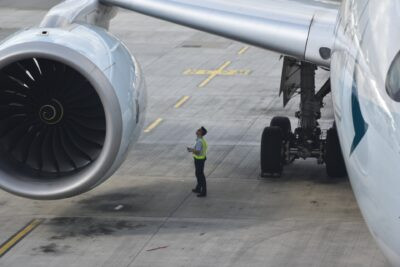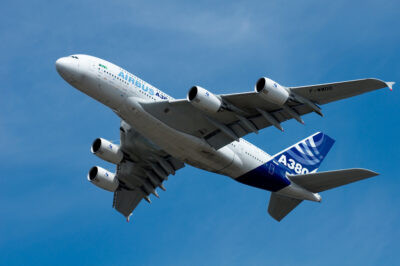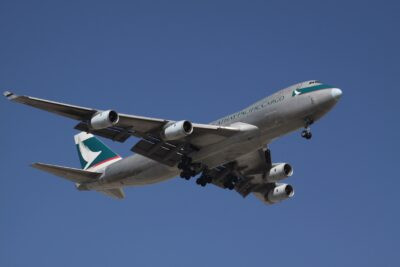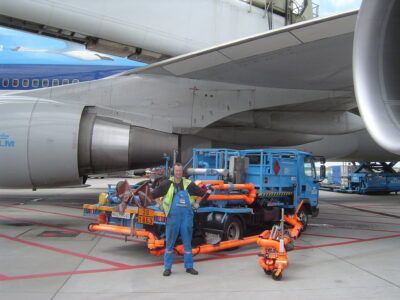Wondering how far a Boeing 747 can fly without stopping? The Boeing 747’s impressive range is a testament to modern aviation technology, allowing for long-distance travel across the globe. At flyermedia.net, we delve into the factors affecting flight range and explore how advancements in aircraft design are pushing the boundaries of air travel, so you can discover the capabilities of this iconic aircraft and what makes long-haul flights possible. Learn about the factors that determine the range, efficiency, and maximum flight time of different aircraft models!
1. Understanding Flight Range of a Boeing 747
How is the flight range of a Boeing 747 determined? The flight range of a Boeing 747, like any aircraft, is influenced by a complex interplay of factors, including aircraft type, weight, weather conditions, and cruising altitude. These elements dictate how far a 747 can travel before needing to refuel.
- Range: The maximum distance a Boeing 747 can fly without refueling is a primary consideration.
- Endurance: The maximum amount of time a Boeing 747 can remain airborne is also critical.
These parameters depend on the aircraft’s fuel capacity and the efficiency of its engines, which are vital variables.
 Understanding Boeing 747 Flight Range
Understanding Boeing 747 Flight Range
1.1. How Payload Affects Flight Range
How does the weight of passengers and cargo impact the flight range of a 747? The amount of passengers, cargo, and fuel on board significantly affects the range of a Boeing 747. As the payload increases, the available fuel for the flight decreases, thereby reducing the aircraft’s range.
1.2. How Weather Conditions Influence Fuel Consumption
How do wind and altitude affect a 747’s fuel consumption? Factors like wind direction, speed, and altitude can significantly influence a Boeing 747’s fuel consumption and, consequently, its range. Tailwinds can increase the aircraft’s ground speed and improve fuel efficiency, allowing it to cover longer distances. Conversely, headwinds can reduce the ground speed and increase fuel consumption, thus reducing the range.
1.3. What Role Does the Flight Profile Play in Range?
How does climbing, cruising, and descending impact fuel usage? The flight profile, including climb, cruise, and descent phases, also affects fuel consumption. Climbing to higher altitudes initially requires more fuel, but once at cruising altitude, the aircraft experiences lower drag and improved fuel efficiency. Descending also consumes less fuel.
2. Optimizing Fuel Efficiency in Aviation
How is fuel efficiency optimized in aviation to extend flight ranges? Optimizing fuel efficiency is crucial not only to reduce operating costs but also to contribute to the industry’s environmental sustainability goals by minimizing carbon emissions. Professionals in the aviation field continuously explore innovative technologies, such as advanced engine designs and lightweight materials, to enhance the flying range and fuel efficiency of aircraft.
Striking the right balance between profitability and sustainability is essential in an increasingly competitive and eco-conscious industry. This information is vital for airlines and aviation enthusiasts alike, highlighting the economic and environmental considerations that shape the industry. Flyermedia.net offers insights into the latest advancements in sustainable aviation practices.
3. What is the Flight Range of Long-Haul Jets?
What distances can long-haul jets cover without refueling? Long-haul jets, such as the Boeing 747 and the Airbus A380, are designed for extended flights and can cover vast distances without refueling. These cutting-edge aircraft can typically fly nonstop for around 8,000 to 11,000 kilometers (4,970 to 6,835 miles) at a cruising speed of approximately 900 kilometers per hour (560 miles per hour). This impressive range allows for direct flights between continents, making intercontinental travel faster and more convenient.
Long-haul jets are equipped with state-of-the-art engines and aerodynamic designs that minimize fuel consumption, making them more environmentally friendly and cost-effective. By exploiting efficient fuel-burning technologies, these jets can fly for extended durations, often surpassing 12 hours, before needing to refuel.
 Boeing 747 Long-Haul Flights
Boeing 747 Long-Haul Flights
3.1. What Is the Fuel Capacity of the Boeing 747?
What is the maximum fuel capacity of a Boeing 747? The Boeing 747 has different models with varying fuel capacities. The most common model, the Boeing 747-400, has a maximum fuel capacity of approximately 216,846 L (57,284 gal.).
3.2. What Is the Fuel Capacity of the Airbus A380?
How much fuel can an Airbus A380 hold? The Airbus A380, too, has different models with varying fuel capacities. The most common model, the Airbus A380-800, has a maximum fuel capacity of approximately 323,546 L (85,479 gal.).
This impressive range is made possible by carefully calculated fuel loads, taking into account factors such as flight distance, weight, and weather conditions. Airlines strategically plan their routes, considering optimal fuel consumption, to ensure safe and uninterrupted travel for passengers.
The remarkable fuel efficiency of long-haul jets not only enables airlines to offer non-stop flights to far-reaching destinations but also contributes to reducing carbon emissions, making air travel more sustainable than ever before.
4. What Are the Capabilities of Ultralong-Range Jets?
How far can ultralong-range jets fly without stopping for fuel? For even longer journeys, ultralong-range jets, such as the Boeing 777X and the Airbus A350 Ultra Long Range, have pushed the boundaries of long-haul flight. These exceptional aircraft can cover distances of up to 16,000 kilometers (9,945 miles) without refueling. With a flight time of up to 20 hours, these jets have opened up new possibilities for nonstop flights between cities that were previously unimaginable.
Ultralong-range jets have gained significant attention in the aviation industry due to their fuel efficiency and ability to fly extended distances without refueling. These cutting-edge aircraft incorporate advanced technologies and design features that optimize their fuel consumption and maximize their range.
 Ultralong-Range Jet
Ultralong-Range Jet
4.1. What Is the Fuel Capacity of the Boeing 777X?
How much fuel can a Boeing 777X hold for ultralong-range flights? The Boeing 777 has different models with varying fuel capacities. The most common model, the Boeing 777-300ER, has a maximum fuel capacity of approximately 47,890 gallons (181,280 liters).
4.2. What Is the Fuel Capacity of the Airbus A350 LR?
What is the maximum fuel capacity of the Airbus A350 LR for extended flights? The Airbus A350 also has different models with varying fuel capacities. The most common model, the A350-900, has a maximum fuel capacity of approximately 37,000 gallons (1400,60 liters).
By utilizing lightweight materials, improved aerodynamics, and state-of-the-art engines, ultralong-range jets can achieve impressive fuel efficiency, allowing them to cover vast distances without the need for frequent refueling stops. According to Boeing, the 777X features folding wingtips that enhance fuel efficiency and airport compatibility. Depending on the specific model and payload, these jets can remain airborne for up to 15 hours or more, surpassing previous limitations and opening up new possibilities for non-stop long-haul flights.
This increased range not only enhances the convenience and comfort for passengers but also offers significant benefits to airlines by reducing operating costs and increasing overall efficiency. As advancements in aeronautical engineering continue, it is foreseeable that ultralong-range jets will continue to push the boundaries of distance, making intercontinental travel more seamless and sustainable.
5. Why Is Fuel Efficiency a Key Priority in Aviation?
How have modern jets improved fuel efficiency for longer flights? To achieve long flight durations, modern jets have become significantly more fuel-efficient. Advanced technology and aerodynamic designs allow aircraft to maximize fuel consumption, reducing the need for mid-flight refueling. This increased efficiency not only extends the range of a jet but also contributes to the environmental sustainability of air travel.
 Fuel Efficiency for Long Flights
Fuel Efficiency for Long Flights
Below are some known ranges based on the aircraft model for reference only:
| Aircraft Model | Approximate Range |
|---|---|
| Boeing 747 | 8,000 – 11,000 km |
| Airbus A380 | 8,000 – 11,000 km |
| Boeing 777X | 16,000 km |
| Airbus A350 LR | 16,000 km |
Note: The ranges mentioned are approximate values and may vary depending on several factors.
These astonishing feats highlight the precision engineering and meticulous strategic planning necessary to ensure safe and efficient long-haul flights, pushing the boundaries of what was once considered possible in the realm of aviation. Embry-Riddle Aeronautical University’s research indicates that optimized flight planning and advanced weather forecasting can further enhance fuel efficiency by up to 5%.
As technology continues to advance, the future of air travel holds even more exciting possibilities. Electric and hybrid aircraft are being developed, aiming to reduce both fuel consumption and carbon emissions. These innovations, combined with ongoing efficiency improvements, will likely lead to even longer flight durations and further redefine the limits of air travel.
6. What Are the Most Common Factors Limiting Flight Range?
What are the typical constraints on how far a jet can fly? Several factors commonly limit the flight range of a jet, including fuel capacity, engine efficiency, weather conditions, and payload. Each of these elements plays a crucial role in determining the maximum distance an aircraft can travel without refueling.
- Fuel Capacity: The amount of fuel an aircraft can carry is a primary limiting factor.
- Engine Efficiency: More efficient engines consume less fuel, extending the range.
- Weather Conditions: Headwinds and adverse weather increase fuel consumption.
- Payload: The weight of passengers and cargo reduces the amount of fuel that can be carried.
These factors collectively dictate the operational range and efficiency of aircraft, influencing route planning and flight economics. Understanding these limitations is essential for optimizing flight performance and ensuring safe and efficient air travel.
7. What Technologies Contribute to Extended Flight Durations?
Which technological advancements enable longer flights? Modern jets achieve extended flight durations through a combination of advanced technologies, including improved aerodynamics, lightweight materials, and state-of-the-art engines. These innovations work together to maximize fuel efficiency and reduce the need for frequent refueling.
- Improved Aerodynamics: Advanced wing designs and streamlined bodies reduce drag.
- Lightweight Materials: Composites like carbon fiber reduce the aircraft’s weight.
- State-of-the-Art Engines: More efficient engines consume less fuel.
- Advanced Navigation Systems: Optimized routing minimizes flight distance and fuel burn.
These technologies represent the forefront of aeronautical engineering, driving the continuous improvement of flight range and sustainability. According to a report by the International Air Transport Association (IATA), these technologies have contributed to a 1.5% annual improvement in fuel efficiency over the past decade.
8. What Innovations Are on the Horizon for Air Travel?
How is the future of air travel being shaped by new technologies? The future of air travel promises even more exciting possibilities with the development of electric and hybrid aircraft, as well as ongoing improvements in fuel efficiency and sustainable aviation practices. These innovations aim to reduce carbon emissions and further extend flight durations.
- Electric Aircraft: Battery-powered planes for short-haul flights.
- Hybrid Aircraft: Combining electric and fuel-based propulsion for longer ranges.
- Sustainable Aviation Fuels (SAF): Alternative fuels made from renewable sources.
- Advanced Air Traffic Management: Optimizing flight paths and reducing delays.
These developments are poised to revolutionize the aviation industry, making air travel more environmentally friendly and efficient. Boeing’s ecoDemonstrator program is actively testing many of these technologies.
9. How Does Route Planning Affect Flight Range?
Why is strategic route planning essential for long-haul flights? Strategic route planning is crucial for maximizing the flight range of a Boeing 747 and ensuring safe, efficient travel. Airlines carefully consider factors such as weather conditions, wind patterns, and optimal altitudes to minimize fuel consumption.
- Weather Routing: Avoiding headwinds and leveraging tailwinds to improve fuel efficiency.
- Altitude Optimization: Flying at optimal altitudes to reduce drag and fuel burn.
- Direct Routing: Choosing the shortest possible routes to minimize flight distance.
- Air Traffic Control: Coordinating with air traffic control to avoid delays and congestion.
By optimizing these elements, airlines can significantly extend the range of their flights and reduce operating costs. According to the FAA, advanced air traffic management systems can reduce flight times and fuel consumption by up to 12%.
10. What Role Do Pilots Play in Maximizing Flight Range?
How do pilot techniques influence the range of a 747? Pilots play a critical role in maximizing the flight range of a Boeing 747 through efficient flying techniques and adherence to optimized flight profiles. Their expertise in managing the aircraft’s systems and responding to changing conditions is essential for achieving the longest possible flight duration.
- Efficient Flying Techniques: Smooth throttle control and optimized climb/descent rates.
- System Management: Monitoring and adjusting engine settings to maximize fuel efficiency.
- Real-Time Adjustments: Responding to changing weather conditions and air traffic.
- Adherence to Flight Profiles: Following pre-planned routes and altitudes for optimal performance.
These pilot skills are crucial for ensuring the safe and efficient operation of long-haul flights. According to training programs at FlightSafety International, pilots can improve fuel efficiency by up to 10% through specialized training in energy management.
Conclusion: The Future of Long-Distance Air Travel
How will future advancements change the limits of air travel? In the world of aviation, the question of how far a 747 can fly without refueling is a testament to the remarkable progress made in the field. From long-haul flights connecting continents to ultralong-range jets breaking barriers, modern aircraft enable us to explore the farthest reaches of our planet without the need to stop for fuel.
As technology continues to evolve, the future of flight holds even greater promise, ushering in an era where the boundaries of air travel are further expanded. So, the next time you embark on a long journey, take a moment to appreciate the incredible feat of engineering that allows you to soar through the skies for hours on end. Whether it’s understanding the intricacies of flight range or optimizing fuel efficiency, flyermedia.net is your go-to resource for all things aviation. We invite you to explore our website for more in-depth information, breaking news, and career opportunities in the world of flight. Are you eager to explore the skies? Discover how flyermedia.net can help you achieve your aviation dreams today!
FAQ: Understanding Flight Range
- How far can a Boeing 747 fly without refueling?
A Boeing 747 can typically fly between 8,000 and 11,000 kilometers (4,970 to 6,835 miles) without refueling, depending on the specific model and conditions. - What factors affect the flight range of a 747?
The flight range is affected by factors such as fuel capacity, payload, weather conditions (including wind), and cruising altitude. - How does payload impact the flight range?
An increase in payload (passengers, cargo, and fuel) reduces the available fuel for the flight, thus reducing the aircraft’s range. - What is the fuel capacity of the Boeing 747-400?
The Boeing 747-400 has a maximum fuel capacity of approximately 216,846 liters (57,284 gallons). - How do headwinds affect the flight range?
Headwinds reduce the aircraft’s ground speed and increase fuel consumption, thus reducing the flight range. - What technologies improve fuel efficiency in modern jets?
Improved aerodynamics, lightweight materials, and state-of-the-art engines all contribute to better fuel efficiency. - Can weather routing extend the flight range?
Yes, by avoiding headwinds and leveraging tailwinds, weather routing can significantly improve fuel efficiency and extend the flight range. - What is the role of pilots in maximizing flight range?
Pilots use efficient flying techniques and system management to optimize fuel consumption and extend the flight range. - How do electric and hybrid aircraft affect the future of flight range?
Electric and hybrid aircraft aim to reduce fuel consumption and carbon emissions, potentially leading to longer flight durations in the future. - Where can I find more information about flight training and aviation careers?
You can find a wealth of information on flight training, aviation news, and career opportunities at flyermedia.net.